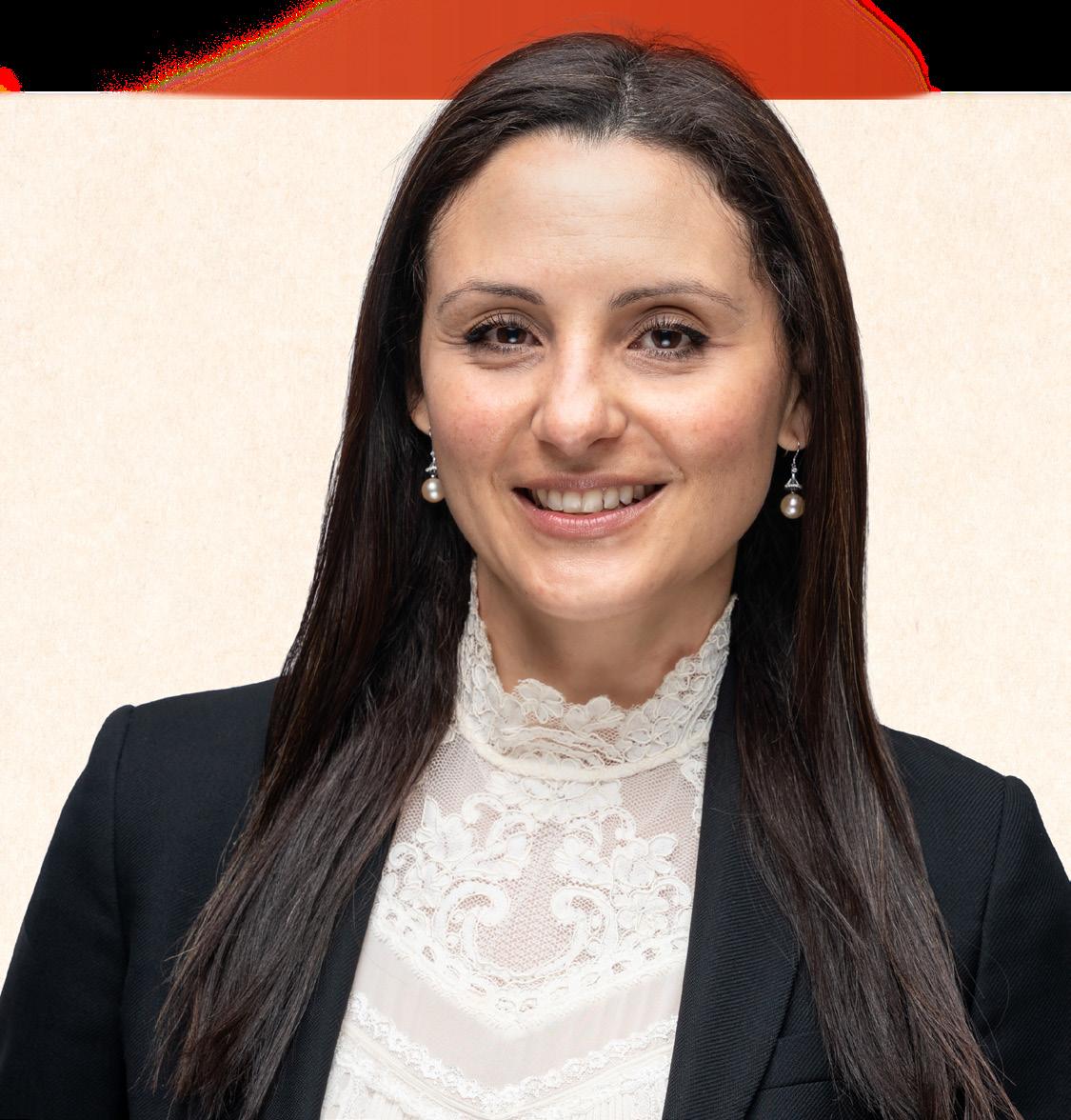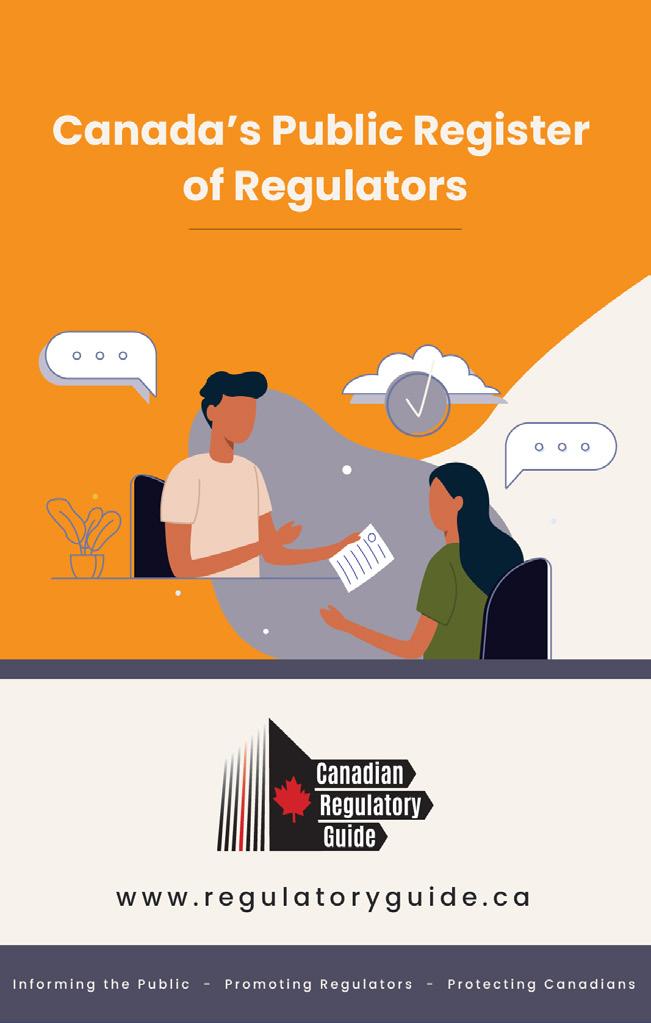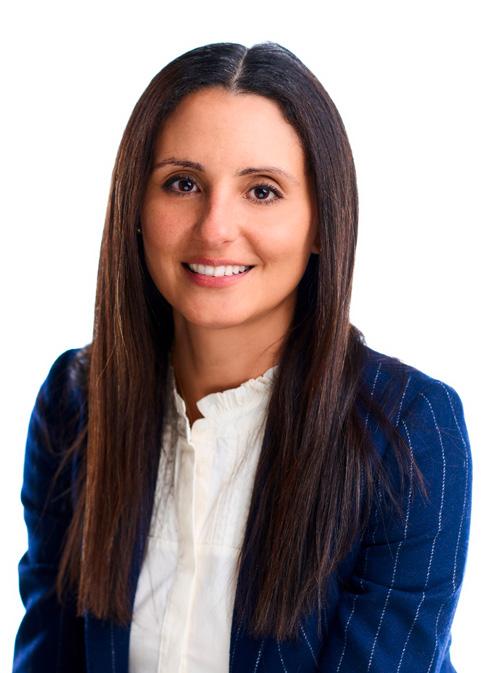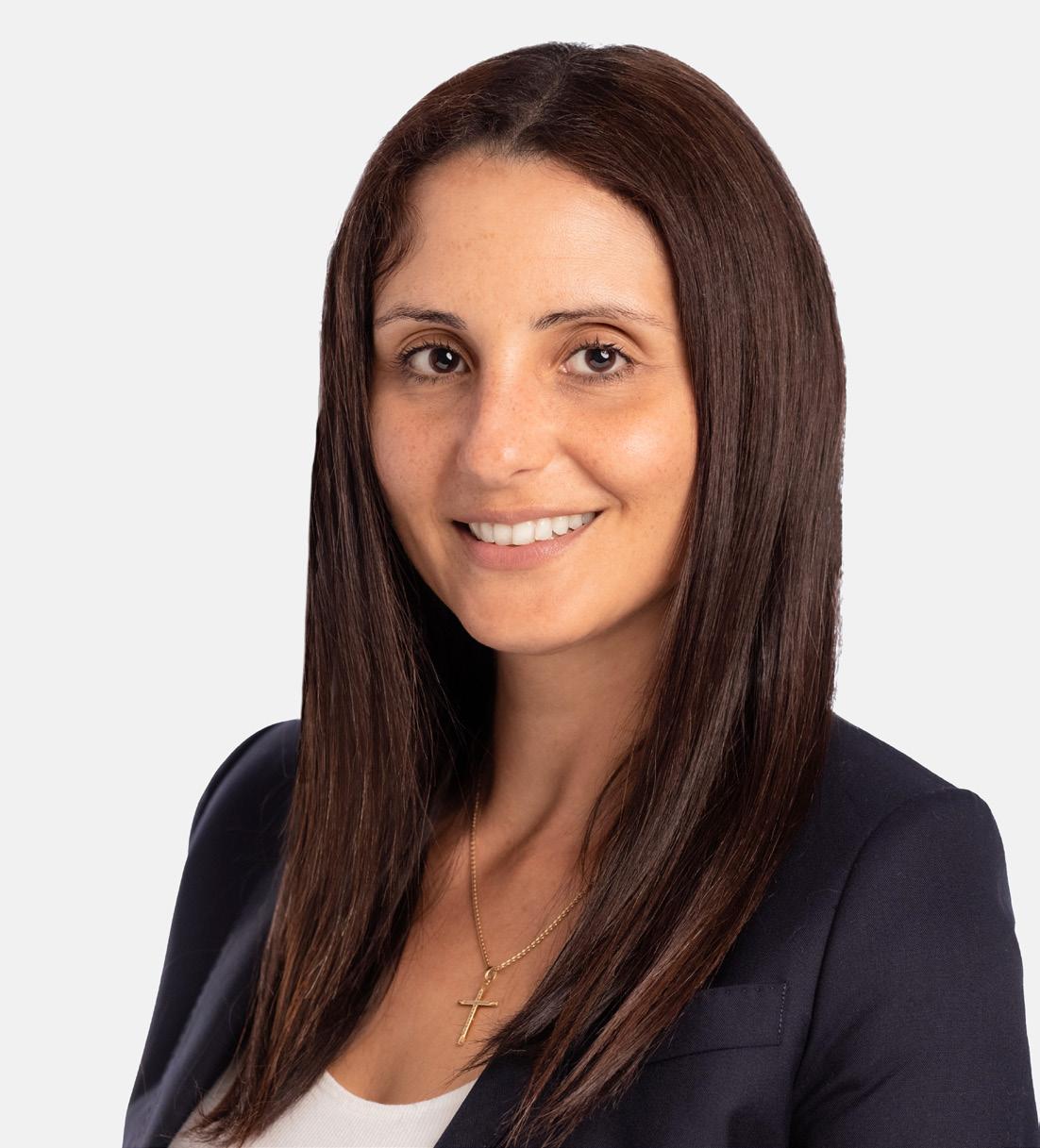The Registrar podcast launches

The Registrant




Alethea Spiridon
Editor in Chief
M. Daniel Roukema
Photo credits Adobe CLEAR DA Photography Dreamstime MDR Strategy Group Ltd. New Brunswick College of Pharmacists Shutterstock Wes Perry Photography
The Registrar magazine is produced and published by MDR Strategy Group Ltd.


Hollis Street Halifax, Nova Scotia Canada B3J 2T9







Earlier this year, Ontario became the last province to sign a $13.2 billion dollar deal with the federal government, which aims to fund child-care over the next six years. Ontarian families were scheduled to receive the first of several rebates recently, with a further fee reduction of 50 percent coming in by the end of 2022.
The goal is to have child-care fees total an average of $10 per day, by September 2025. Licensed operators looking to opt into this program have until November 1 to agree to the deal, a change from the original September 1 deadline.

Despite delays, many organizations praise the necessity of a daycare plan to better serve families.
The College of Early Childhood Educators, Canada’s only regulatory body that licenses professionals in the sec tor, gives a nod to the deal made between both levels of government.
In a press release, the College says that it is an “important agreement that when fully implemented will make a significant difference in the lives of children and families.”
Several elements of the deal complement the College’s aims, including the highlighted affordability of ser vicing to Ontarian families, as well as granting access to high-quality childcare in the province. Dr. Cynthia Abel, Deputy Registrar and Director of Registration, says that ensuring quality child-care is prioritized remains a key focus of the deal.
“Staffing is a key component of any
quality program, and it’s that interaction between the educator and children that creates a quality en vironment,” Abel says. “Investing in staffing is important, to ensure that licensed operators can adequately support kids and their families.”
Like many other professions, COVID-19 has strained resources and affected operators’ ability to do their jobs effectively. From burnout, to understaffing, the new program has brought forth several mechanisms of tangibly addressing those gaps.
Supplementing that, Abel says, is the College recently partnering with Peo ple Connect, a mental health resource centre offering self-care and support tools to all Registered Early Child hood Educators (RECEs) at no cost to registrants.
Better support systems will become apparent as the deal is fleshed out she says, which will not only benefit those currently working in the sector in terms of wages and working condi tions, but for supporting burgeoning child-care professionals and undecid ed licensed operators looking to opt in.
Municipalities across the province are welcoming the latter. Shanley McNamee, General Manager of Children’s
This is just the beginning, but there is a lot more to be done.
Services at the City of Toronto, says that despite the complexities, Toronto has provided resources to help undecided operators with their decision-making. Revised guidelines by the provincial government regarding the deal have also been beneficial McNamee says, as both municipali ty and operators alike have had their voices heard.
had 60 days to refund parents; now they have 20. These condensed timelines, ideally this year, quickly allow families to benefit from that financial relief.”

Should the deal rollout in the way that all parties are accepting of, Abel says a highly-engaged workforce remains crucial, so that families can access the child-care servicing they deserve.
Making sure that workforce needs are addressed is key, she explains. Paying attention to communal activities, as well as using and analyzing gathered data, will allow the College to offer even more tangible support systems to registrants, and the public at large.
“One of the changes included in the revised guidelines was direction to service system managers and operators about speeding up the rollout in 2022,” she said. “Previously, operators
“I think that a plan just can’t happen without the people,” Abel says. “For us at the College, it is about ensuring that our practices don’t create unnecessary barriers to those trying to register, while also establishing
For us at the College, it is about ensuring that our practices don’t create unnecessary barriers.
appropriate thresholds to safe, and ethical practicing. These will inevitably set up everyone for success.”

Adebola Adefioye, Project Officer at the Ontario Coalition For Better Childcare praises the work of the College, and notes that the established program sets a solid foundation. It is a step in the right direction, she says, as it has taken 50 years of advocacy by child-care leaders across the province and country to build towards a system that works for families.
Continuing to ensure that regulated
child-care spaces are present remain key Adefioye says, as it is a base for safety and quality that every fami ly deserves, along with expanding public and non-profit spaces. The same is true for families who don’t have consistent access to the sector.
“This is just the beginning, but there is a lot more to be done,” Adefioye said. “It is important that govern ments across Canada, and child-care sector leaders, listen to underserved and racialized families as that is the only way to build a truly inclusive and equitable system.”

On a service road off Jones Lake in Moncton lies a building whose few occupants assume the sizeable task of protecting the province’s pharmacy patients.
Led by registrar and CEO Anastasia Shiamptanis, PharmD, MHSc., the New Brunswick College of Pharma cists is the provincial body that governs and regulates the practice of pharmacy. It places patient safety above all, which has always been a driving force behind her professional philosophy.
“Patient safety certainly underpins everything [in my career],” says Shiamptanis, who joined the Atlantic re gion College in 2021. “While patient safety remains at the core, over time, I have learned to lean more into my in tuition. When that intuitive signal is accessed, it’s time to be more curious about a decision.”
Shiamptanis grew up in Cobourg, Ontario, in what was a town of just 15,000 residents at the time. Having a tight-knit community around her has had a profound impact, from ev eryone knowing each other in the neighbourhood to going to the one community pharmacy for healthcare needs.
The local pharmacy was incredibly in fluential, Shiamptanis told The Reg istrar magazine. She reflects on the moment it became the force behind her career choice, and how considerate and kind patient care makes all the difference.
“I was self-conscious about a particular dermal rash and chose to go the pharmacy as it was familiar and comfortable,” she said. “I remember the way my pharmacist helped me through this situation, and the mo ment was special because of how [the pharmacist] made me feel. I wanted to be like this person, and knew that in high school, I wanted to become a pharmacist.”
Years later, Shiamptanis earned her Doctor of Pharmacy at the Albany College of Pharmacy of Union University in New York in 2007. She then re ceived her Master’s in Health Science at the University of Toronto in 2019.
Early in her career, Shiamptanis was a pharmacist and pharmacy manager at Shopper’s Drug Mart, Toronto Rehabilitation Institute, and Lakeridge Health. Attracted to the advance ment of the profession and the need for strong patient safety, she joined the Ontario College of Pharmacists as strategic policy lead from 2018 to 2021. Shiamptanis also taught at the Leslie Dan Faculty of Pharmacy at the University of Toronto.
Applying the lessons gained in her earlier roles as a clinician, her guiding principle has always been to aim to optimize health care to prevent harm.
While her roles have changed throughout the years, she said that her patient-first principle has never wavered. She explains that the overarching goal of public safety resonates as a regulator whose mandate is to set and uphold professional stan dards for optimal patient care.
“We have the protected titles of Pharmacist and Pharmacy Technician, and regulatory bodies must support these professionals in achieving the stan dards they set,” Shiamptanis said. “[We as] licensed professionals are doing all that we can for our patients
in different ways; mine, as a pharma cist and regulator, is just a unique way of achieving that same goal.”
The current strains in healthcare across all sectors have forced organizations and consumer protection practitioners to find new ways to address prevailing issues. Shiamptanis says due to the COVID-19 pandemic, there is a greater awareness of how resources can be better utilized when discovering potential solutions.
She says that is key when presenting patients with all possible options, which includes providing better in formation to consumers while also continuing to empower pharmacy professionals, with regulatory bodies assisting along the way.
Shiamptanis says she is most excited about the organization’s Strategic Plan 2023, which continues to place patient care at the core of the organi zation’s work. She says that the new plan’s focus stems from four pillars:
1. Fostering continuous quality im provement in the profession.
2. Supporting the evolving role and well-being of pharmacy professionals.
3. Enhancing engagement and collaboration with pharmacy profes-
sionals, the public, and health system partners.

4. Demonstrating transparency and accountability in self-regulatory responsibilities.
“I’m excited about Pillar One in the Strategic Plan because many may not know just how much work a regulator does to foster quality assurances concerning patient care in pharmacy,” she said. “This goes hand-in-hand with Pillar Two, which is to support the well-being of pharmacy professionals and address well-being as an import
ant part of professional practice.”
“We really want to provide more op portunities to engage with pharmacy professionals, stakeholders, and the public, so that input and feedback can not only influence our regulatory instruments but really align with what is happening in practice and with patient care needs,” she said. “Pharma cists can now assess and provide access to medication, such as Paxlovid, in a timely manner, which shows that we can provide options to consum ers in a modern, systems-based approach.
Recently, while attending the Dal housie University School of Pharmacy White Coat Ceremony, an event inducting first-year pharmacy students, the energy and enthusiasm of future pharmacists inspired and motivated her. Today’s youth remain energized, focused, and ready to rise to the chal-
lenge in a world where the future is more uncertain than any in most people’s memories.
“When I was there, I felt pride for two reasons,” Shiamptanis said. “The first was feeling proud of the students and their families who supported them, and the second was pride in how I can now be on this stage and inspire the next generations of pharmacy professionals.”
As for her work, Shiamptanis says that knowing there is always progress to be made continues to drive her.

Recognizing that protecting patients is a never-ending commitment, and improving standards, recognition, and support for the profession are critical components for relevant reg ulation, she says working with other healthcare leaders with a shared vision of achieving that aim is gratify ing.
With a smile, Moncton’s new resident adds, “I hope that it’s my intuition telling me [I’m doing] the right thing.”



Across Canada, there is a push by governments to improve the state of our healthcare.
It would be a futile argument to dis agree that the almost three-year-old COVID-19 pandemic has changed healthcare as we know it in Canada. From overworked nurses to limited resources due to supply chain issues, and unprecedented financial pressures to a backlog of more than one million surgeries, the status quo, already in dire need of repairs, has collapsed.
Stephanie is a 46-year-old nurse from Ottawa who has worked in intensive care and other areas of her profession for 25 years. Requesting to withhold her last name for reasons of privacy, she is one of the latest nurses who has announced she’s leaving profession.
“I’m done. I just can’t do it anymore,” she expressed in an interview with The Registrar magazine. “While I appre
ciate the outpouring of support from the public towards healthcare workers, the reality is that we need better in frastructure, improved mental health supports, and more nurses. It feels as though the burden has been put on us to make Canada healthy again, but we just can’t do it alone.”
These sentiments are not isolated to Ontario, but reverberate across the country, and, in fact, around the world. Already at their breaking point in Can ada prior to the pandemic, the collective exhaustion faced by healthcare professionals, financial challenges, and limits on resources has forced governments, organizations, regulators, and associations to find solutions.
One answer to bring reinforcements to the frontlines of the Canadian healthcare system is accelerating the licensing of foreign-trained healthcare prac titioners.
In August, Ontario’s health minister, Sylvia Jones, directed the province’s regulatory colleges for nurses and physicians to find solutions to speed up the registration process of internation ally trained nurses and doctors.

In response, the College of Nurses of Ontario (CNO) updated its Temporary Registration and Reinstatement regu lations, allowing for the quicker registration of nurses.
“We are resolutely committed to protecting the public by registering safe and competent nurses,” said Silvie Crawford, Executive Director and CEO of the CNO in a recent announcement.
“The regulation changes proposed by Council today [Sept. 29, 2022] will allow CNO to build on an already successful year, where we are breaking records for nursing registrations in On tario.”
Some of those ongoing changes, which were originally included in an
August 2022 response letter to the Minister of Health, include:
• Regulation changes so that more IEN applicants can register in the Temporary Class enabling them to work in the system while they continue to meet requirements for General Class registration.
• Continuing existing strategies, such as the Supervised Practice Experience Partnership program.
• Surveying IEN applicants to understand the reasons why they delay taking their registration exam, which may lead to the identification of other actions that CNO, or our system partners, can take.
“As leaders in nursing regulation, Council is pleased that the proposed changes serve our purpose to protect the public,” Naomi Thick, CNO Council President, said.
To address frontline nursing shortages, the BC government outlined in an April 2022 press release their intention to make the process simpler for internationally educated nurses, or IENs.
The British Columbia Colleges of Nurses and Midwives (BCCNM), alongside the Nursing Community Assessment Service and Health
Match BC, partnered with the provincial government to facilitate these support systems, which include:
• consolidating the provincially based assessment processes for IEN candidates.
• offering approximately $9 million in bursaries to help with assessment fees, which is expected to benefit approximately 1,500 IENs in the first year.
• creating new nurse navigator positions to help IENs navigate the assessment and licensing process.
“Our government is committed to addressing the province’s demand for nurses,” current B.C. Minister of
The pandemic has demanded a lot of the nurses we regulate, who have been called upon to deliver care under extraordinary circumstances.
Health Adrian Dix said in the release. “That’s why we’re launching this comprehensive suite of supports for inter nationally educated nurses to help them put their skills to use here in B.C.”
Of particular note were the for ward-thinking initiatives set out to make the rollout of support systems easier for IENs. Health Match BC and the province are currently working together to provide IENs with bursaries, ranging from $1,500 to $16,000. These were intended to offset the costs of registration requirements to practice, such as assessment services, language testing, skill evaluation and educational upbringing.
In conjunction with this initiative, the BCCNM announced in May 2022 that it aimed to redesign its application systems into a more consolidated
framework. IENs will now only be required to submit a single application and one fee, which results in reduced application costs, ensuring they gain registration sooner in their preferred designation.
“The pandemic has demanded a lot of the nurses we regulate, who have been called upon to deliver care under extraordinary circumstances,” Regis trar and CEO of the BCCNM Cynthia Johansen said in the aforementioned B.C. government press release.
“It has also underscored the need for more nurses in our health-care system. We are delighted to be partnering with the Ministry of Health and NCAS to remove barriers wherever possible and bring internationally educated nurses into the system safely and efficiently.”

Nova Scotia has also actively been developing a framework to accelerate registration processes for foreign-trained healthcare workers.
Currently, an internationally trained physician must first obtain a Defined license to practise under the prov ince’s Medical Act. It is time-sensitive, and may be issued to physicians without the qualifications for a full license, as they work towards Canadian licensing certification standards.
A new streamlined approach, announced by the College of Physi cians and Surgeons of Nova Scotia in August 2022 in a press release, discussed the changes to Defined licensure, enabling faster decisions to be made for professionals to practise. After obtaining the new Defined license, the system will:
• provide a comprehensive orientation program for physicians.
• reduce the required time physicians on a Defined licence must practise under supervision.
• focus on demonstrated competency rather than certification.
The College’s streamlined strategy was informed by half a decade’s worth of data, alongside working with spon sors and supervisors who oversee the
licensing pathway of physicians seeking full licensure.
Similarly, a strategy was undertaken by the Nova Scotia College of Nursing, where IENs can practise faster through reduced registration and licensing wait times.
In an August 2022 press release, the provincial government issued a onetime funding of $340,000 in June 2022 to the College. This was to assist the ongoing review of registration requirements for IENs aiming to work in the province. While the College has

already taken the reins in expediting this process, the additional sup port will grant IENs better support systems when it comes to practising without feeling overburdened.
“NSCN is pleased to receive funding from the provincial nursing strategy to support our work to continue to evaluate and change the registration and licensure processes to reduce the time it takes for qualified internationally educated nurses to receive a nursing licence,” Sue Smith said, the Registrar and CEO of the NSCN.
Some of these changes include, but are not limited to:
• adding more options for IENs to meet the English language proficiency registration requirement.
• streamlining and reducing the documentation required of IENs.
• providing conditional licences to nurses already registered, licensed and in good standing elsewhere in Canada, which allows them to enter practice while completing the remaining registration requirements.

“While we are very pleased with the changes we have made to our policies thus far, we are committed to continuing to evaluate our policies to make sure they are relevant, flexible and positively contribute to the supply of nurses, while simultaneously meeting NSCN’s legislated mandate to protect the public”, Smith said.
The efforts are intended to reverse the tide of a challenged healthcare system. With new approaches and more healthcare practitioners, the provincial governments might have found the answers.



The Registrar podcast launched in September at the Council on Licensure, Enforcement and Regulation (CLEAR) conference, in Louisville, Kentucky.
Host Daniel Roukema invited professionals who dedicate their careers to protect the public for a conversation about their work, life, and ambitions. Available in video and audio formats,
new episodes of The Registrar pod cast will be recorded and released throughout in between The Registrar magazine’s publication dates.
Marc Spector is Deputy Registrar of the Home Construction Regu latory Authority in Toronto. At the time of recording, Marc’s election to President-Elect of the Council on Licensure, Enforcement and Regulation (CLEAR) had not yet been announced. Listen to Marc discuss relevant regulation and his vision for CLEAR. Also a big thumbs up to the people of Kentucky from Marc.

Michael Carpenter is the CEO of Australian Psychology Accredita tion Council. Based in Melbourne, he sat down with host Daniel Roukema to discuss licensing and professional regulation, Australia vs. England, family, travel, and life.


Dr. Hany Abdelhady is a public member on the Council of the College of Psychiatric Nurses of Alberta (CRPNA), and a pharma cist at Alberta Health Services. In this episode, he discusses his education and career abroad and in Canada, and life as a healthcare practitioner during COVID-19.

Watch/listen to Dr. Hany Abdelhady

Staci Mason is the Director, American Medical College Application Service Operations at the Association of American Medical College in Washington, DC. In this pod cast, host Daniel Roukema and Staci Mason compare notes about Equity, Diversity, Inclusion, and racism. Listen to this candid and emotional dialogue from the per spectives of an African American and Black Canadian.
Watch/listen to Staci Mason





Jasmine Shaw’s LinkedIn profile clearly showcases the young engineer’s profession and ambi tions: engineer, changemaker & entrepreneur, designing solutions to technical and social problems.
At a time when clear efforts are made to break down structures that limit diversity, young leaders like Shaw have harnessed the opportunity to re define professions, the marketplace, and even purpose.
For Shaw, hers began in high school when deciding what career to pur sue. Instead of selecting a future that captivated a lifelong dream, she recognized her love for math and science and went into engineering because it would be a challenge.
“I wanted to see if I could do this really hard thing,” Shaw told The Reg istrar magazine. “I chose this early on over other programs since I thought they wouldn’t necessarily provide the same challenge.”
To be challenged, and to see how far her ambitions could take her have become her defining characteristic.
Born and raised in the national capital region, Shaw attended Carleton University. It was an easy choice and fam ily affair as both of her parents also attended the same Ottawa post-secondary institution.
After graduating in 2016 with a Bachelor in Biomedical and Mechanical Engineering, Shaw worked as an Engineer in Training (EIT) at General Dynamics Mission Systems Canada. She received her P.Eng designation from Professional Engineers Ontario in 2021, and now works as a technical project manager overseeing complex programs at Solace, an Ottawa-based tech company. She also sits on the company’s Diversity, Equity, and In clusion committee.

“Even though I am currently working in a more engineering-adjacent field of project management, it was still important to me to have that designation,” Shaw said.
At Carleton University, she was heavily involved with student politics, hav ing been active in the engineering society and other student associations. Underlying all of her extracurricular activities was Shaw’s commitment to create impact and challenge the sta tus quo.
A few years after earning her under graduate degree, Shaw challenged herself to take on larger initiatives, notably, pursuing a Maser of Applied Science in Technology Innovation Management. Her research on Tech novation, the world’s largest tech entrepreneurship program for girls, was one of the turning points driving her into social impact.
“The research I did here [for Technovation] was the catalyst for many things,” Shaw said. “It was my first exposure to STEM entrepreneurship, and it inspired me to do something with this passion I had for helping women in the field.”
Witnessing the powerful impact that a dedicated community for girls in tech had on Technovation partici pants, Jasmine was inspired to create a community of her own. It was
the spark for her to take up content creation and podcasting (she hosts a weekly show, #TechTalks, on Insta gram Live), offering inspiration, sharing lessons, and creating connections for the next generation of women in STEM. These activities are now one branch of Jasmine’s small business, whose overarching mission is to help women in STEM achieve their full potential.
On licensing and regulation Shaw commends the regulatory mechanisms in place within engineer ing, as they act as guardrails where

innovation can occur. Though innovation may be commonly thought of as boundless, she says that it should be thought of within the realm of what is viable, safe, and what can provide net positive benefits to the public.
However, Shaw explains that, some times, the pace of regulation may be at odds with the speed of innovation. Technology can be challenging to keep up with, and regulatory bodies, she says, need to mindful of the re quirements they set for registrants, to avoid excluding anyone who can provide value to the profession where guidelines may not yet have been written.
Ensuring there are enough opportunities present that enable newer licensed professionals to advance in their career also remains important to Shaw. Many higher-calibre professional development efforts, Shaw says, appear targeted towards senior-level professionals who are well-established in their professions and demographically homogenous. Shaw is hopeful that more inclusive training opportunities tailored to the broad representation of engineers will be developed.
For girls and young women looking to get into the field, despite its hurdles, Shaw says that it always helps to re main passionate and dedicated.
Shaw says that while it is imperative to gain more diversity in the field, there may be bumps in the road. Many come into a field that is not necessarily inclusive, but their involvement is still needed to chart a trailblazing new course, she says.
“The advice that I would give to young women starting out in engineering is to really be persistent,” Shaw said. “Weave those traits into your work, in spite of those bumps in the road, and find your mentors and sponsors who will genuinely help you navigate those challenges.”
Above all else, Shaw notes the importance of staying curious, as a means to constantly challenge yourself. She says that this lesson dovetails with defining leadership as action, as it acts as a compass to create positive change in a designated field.
If there are issues in the workplace related to diversity, equity, and inclusion, for example, Shaw says it is im portant to ask questions, which can challenge pre-existing assumptions. Getting to the issue’s root allows you to better understand the problem, before finding the applicable solu tions.
“You’re helping to create the work place of tomorrow for those who come after you,” she said. “It’s moti vating that, even with the challenges, you’ll always be able to contribute to creating a better profession.”
Connect with Jasmine on LinkedIn, Instagram (@jasmineashaw), or www.jasmineshaw.ca

